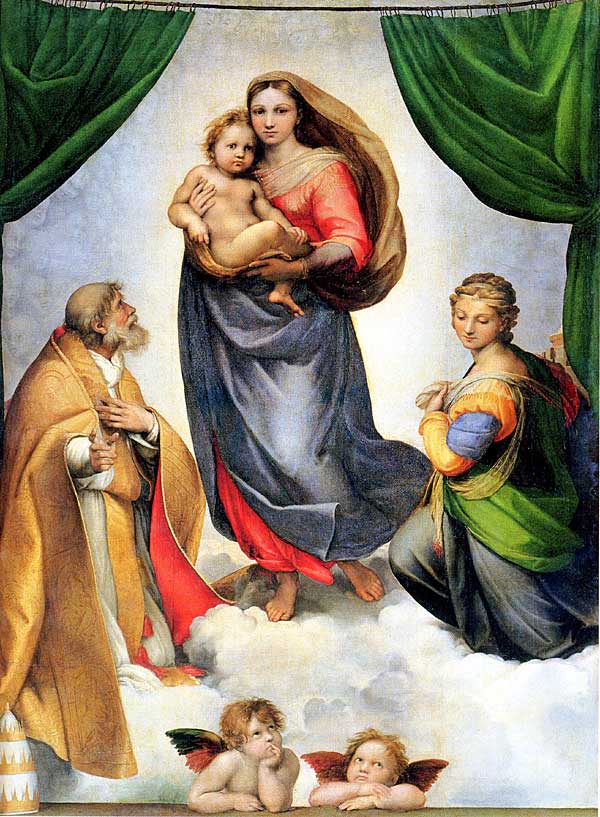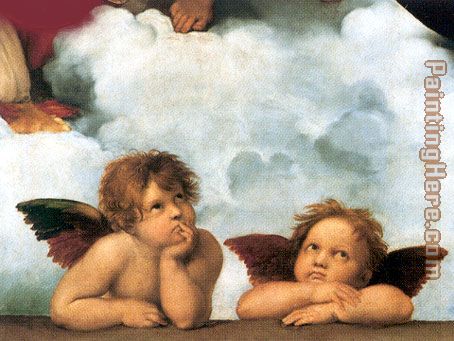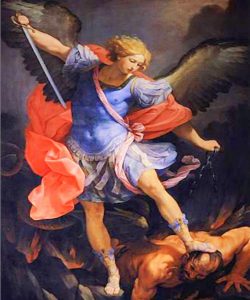___________________________
Raphaels Angel Painting

- Title: The Sistine Madonna
- Date Created: 1512 – 1513
- Physical Dimensions: w201 x h269.5 cm
- Painter: Raphael
- Collection: Gemäldegalerie Alte Meister (Old Masters Picture Gallery)
- Type: Painting
- Rights: Gemäldegalerie Alte Meister, Staatliche Kunstsammlungen Dresden
- Photograph: Hans Peter Klut/Elke Estel
- Current Location: Gemäldegalerie Alte Meister in Dresden, Germany
- ___________________________
Raphael was an Italian Renaissance artist and considered one of the greatest artists of all time.
He is part of the Trinity of Great Masters that includes Raphael, Michelangelo ,and Leonardo Da Vinci.
Raphaels Angel painting is also known as ‘The Sistine Cherubs’ and ‘Raphael’s Two Putti’. (Putti = cherubim)
Though typically appearing in isolation, the cherubim are taken from a much larger work: The Sistine Madonna or La Madonna di San Sisto. Raphael’s Angels are seen at the bottom of the “Sistine Madonna“.
The Sistine Madonna depicts Mary with the Christ child and two Saints, Sixtus and Barbara, in the clouds with the two Cherubs looking up at Madonna with Child.
This legendary Sistine Madonna (also called La Madonna di San Sisto) is a large oil on canvas 265 cm × 196 cm (104 in × 77 in). This painting was created between 1512 and 1513 on a flax-covered wall in the Benedictine monastery church of San Sisto. Finished a few years before his death, ca. 1513–1514, as a commissioned altarpiece, it was the last of the painter’s Madonnas and the last painting he completed with his own hands.
During World War II the Sistine Madonna was taken by Hitler and vaulted to protect it from Allied bombing.
After the war, the Sistine Madonna was taken to Russia where Stalin had it vaulted as well. In the late 1950’s, the painting was returned to Germany where it resides to this day in Dresden, in the Old Master Gallery (Gemäldegalerie Alte Meister).
The painting has been highly praised by many notable critics, and Giorgio Vasari called it “a truly rare and extraordinary work”.
The ‘Cherubs from the Sistine Madonna’ by Raphael (Sanzio) can be viewed in the Gemäldegalerie Alte Meister in Dresden, Germany.

___________________________
History
The original ‘The Madonna of San Sisto’ was commissioned by Pope Julius II, who is depicted in the painting as the Holy Sixtus. Descended from the noble Della Rovere family of Italy, Pope Julius II may have requested the painting for his tomb, as the patron saint of his family was Saint Sixtus.
The painting’s figures consist of the Virgin Mary holding the Christ child, Saint Sixtus, and Saint Barbara who is looking down at the little cherubs whose facial expression seems to imply boredom and restlessness. They appear eager to finish their holy duties and be free to play. Regardless of their intent, they add a sense of intrigue to the scene, contrasting beautifully with the humorless miens of the figures above them.
The painting was sold to Germany by the monks of the Benedictine Monastery, where it was originally displayed on the altar of the church of San Sisto in Piacenza.
The Sistine Madonna is one of Raphael’s most famous works. The painting takes its name from the church of San Sisto in Piacenza and Raphael painted it as the altarpiece for that church in 1513-1514.
The two saints that feature in the painting, St Sixtus and St Barbara are the patron saints of the Benedictine San Sisto church, hence their inclusion in Raphael’s magnificent masterpiece.
The piece was purchased in 1754 by King Augustus III of Saxony for his collection in Dresden. In Germany the painting was very influential, sparking debate on the questions of art and religion.
___________________________

___________________________
Raphaels angel painting
___________________________
LINK Raphael’s Transfiguration
Raphaels angel painting


